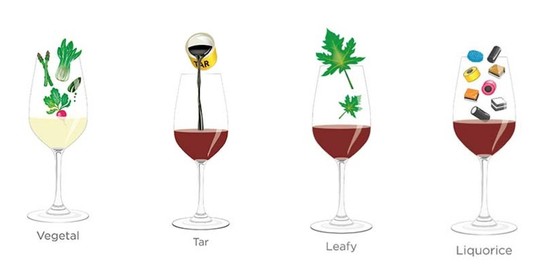
Vegetal
When describing wine, vegetal can be used in a negative or positive sense — as with most tasting notes it’s a question of balance. If the vegetal character is too overbearing, it can become an unpleasant indicator that the wine is too ‘green’, meaning the grapes used were unable to ripen properly before being harvested.
Or alternatively, as with fruity notes, it can appear as unattractively over-developed or stewed. Such as one Chianti Classico Riserva described by Michael Palij MW as ‘vegetal with sweat, cabbage’.
Vegetal notes can also be associated with the term ‘stalky’, when wines have had too much stem contact. This can happen during a winemaking process such as whole bunch fermentation, where the stems are not removed before the fruit goes into the fermentation vat. Decanter’s Jane Anson discusses its use in her article Whole bunch winemaking shakes up Bordeaux. She says that in the past the prevailing opinion has been: ‘Merlot, Cabernet Franc and Cabernet Sauvignon have too much vegetal/green flavour in their varietal DNA (specifically a molecule known as pyrazine) to withstand the use of stems that can lead to bitterness in the final wine.’ However, recently several high profile winemakers have begun to see potential in the process.
The divided nature of the vegetal flavour can be seen by comparing the styles of Sauvignon Blancs from New Zealand and the Loire. ‘No self-respecting Loire grower would deliberately aim for vegetal characters; on the other hand many New Zealand growers do precisely that,’ explains Decanter’s Stephen Brook.
At its best, vegetal can be enjoyed as a sign of herbaceous complexity; alongside gamey and earthy notes in mature Pinot Noirs, or in the asparagus quality of some Sauvignon Blancs.
Tar
Tar may seem an unlikely substance to be evoked by wine, but as with notes of tobacco and petrol it can be an unusual source of pleasure. If expressed in harmony with the other flavours and aromas of the wine, tar can add a pungent edge, the kind to make your nostrils dilate.
It is usually used as a savoury descriptor of red wines; Barolo wines from Piedmont are most commonly ascribed a tar-like quality. They are made from the thick-skinned Nebbiolo grape, and usually have high acidity with no shortage of tannins. Nebbiolo’s bouquet encompasses violet, smoke and rose-like perfumes, with flavours that include truffle, fennel, liquorice and, most famously, tar.
However, as with other distinctive tasting notes, if you have an intense dislike for the smell of asphalt it can be too distracting, and detract from your appreciation of other aromas and flavours in the wine.
Leafy
This aroma does not come from leaves of the vine but is a flavour compound found in the skin of the grape: methoxypyrazine. This herbaceous character, which can be typical of cooler-climate Cabernet Sauvignon and is present in many Sauvignon Blancs, can be associated with a lack of ripeness. However, it can also give extra complexity to the wine if it is not too overt. Leafiness can evolve into a cigar box character when the wine is aged, but if the wine is too leafy to begin with then it may never reach its full potential as the tannins will also be unripe.
Liquorice
As a wine descriptor, liquorice refers to the sweet, yet slightly bitter and medicinal flavours and aromas associated with the chewy black confection made from the Glycyrrhiza glabra plant root extract.
Although this is not actually present in the wines themselves, its likeness is often perceived in red wines, such as Syrah blends from Rhône, and is usually integrated with black fruit flavours. Or in the spiciness of wines made from the Nebbiolo grape, such as Barolo and Barbaresco wines from northwest Italy, where it is often expressed in harmony with violet and rose aromas.
Liquorice is part of the same flavour group as star anise and fennel, as they share chemical flavour compounds such as anethole, which is found widely in essential oils, and is responsible for their distinctive scent and taste.
It is a useful term to use to describe a particular tart and penetrating sweetness, differing from that related to sugar. Like liquorice itself, wines with this flavour or aroma can be divisive depending on personal taste; for some it recalls childhood treats, for others it causes nose-wrinkling.
Translated by ICY
All rights reserved by Future plc. No part of this publication may be reproduced, distributed or transmitted in any form or by any means without the prior written permission of Decanter.
Only Official Media Partners (see About us) of DecanterChina.com may republish part of the content from the site without prior permission under strict Terms & Conditions. Contact china@decanter.com to learn about how to become an Official Media Partner of DecanterChina.com.











Comments
Submit